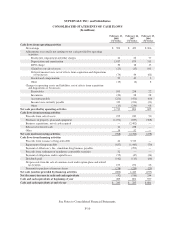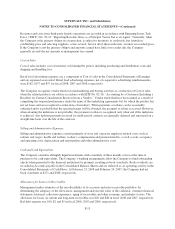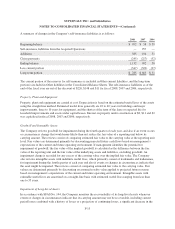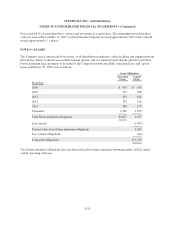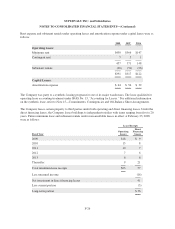Albertsons 2008 Annual Report Download - page 83
Download and view the complete annual report
Please find page 83 of the 2008 Albertsons annual report below. You can navigate through the pages in the report by either clicking on the pages listed below, or by using the keyword search tool below to find specific information within the annual report.SUPERVALU INC. and Subsidiaries
NOTES TO CONSOLIDATED FINANCIAL STATEMENTS—(Continued)
the Black-Scholes option pricing model, which incorporates certain assumptions, such as risk-free interest rate,
expected volatility, expected dividend yield and expected life of options. Prior to the adoption of SFAS
No. 123(R), the Company utilized the intrinsic value based method, per Accounting Principles Board (“APB”)
Opinion No. 25, “Accounting for Stock Issued to Employees.”
Income Taxes
The Company provides for deferred income taxes in accordance with SFAS No. 109, “Accounting for Income
Taxes.” Deferred income taxes represent future net tax effects resulting from temporary differences between the
financial statement and tax basis of assets and liabilities using enacted tax rates in effect for the year in which the
differences are expected to be settled or realized.
Effective February 25, 2007, the Company adopted the provisions of Financial Accounting Standards Board
(“FASB”) Interpretation No. (“FIN”) 48, “Accounting for Uncertainty in Income Taxes—an Interpretation of
FASB Statement No. 109.” FIN 48 clarifies the accounting for uncertainty in income taxes recognized in an
entity’s financial statements in accordance with SFAS No. 109, and prescribes a recognition threshold and
measurement attribute for the financial statement recognition and measurement of a tax position taken or
expected to be taken in a tax return. Additionally, FIN 48 provides guidance on subsequent derecognition of tax
positions, financial statement reclassification, recognition of interest and penalties, accounting in interim periods
and disclosure requirements. The Company recognizes interest related to unrecognized tax benefits in Interest
expense and penalties in Selling and administrative expenses in the Consolidated Statement of Earnings. This
policy did not change as a result of the adoption of FIN 48.
Net Earnings Per Share
Basic net earnings per share is calculated using net earnings available to stockholders divided by the weighted
average number of shares outstanding during the period. Diluted net earnings per share is similar to basic
earnings per share except that the weighted average number of shares outstanding is after giving effect to the
dilutive impacts of stock options, restricted stock awards and outstanding convertible securities. In addition, for
the calculation of diluted net earnings per share, net earnings is adjusted to eliminate the after-tax interest
expense recognized during the period related to contingently convertible debentures.
Reclassifications
Certain reclassifications have been made to conform prior years’ data to the current presentation. The Company
made a reclassification to properly reflect accumulated depreciation and amortization on Property, plant and
equipment in the Consolidated Balance Sheet as of February 24, 2007, which resulted in an increase in
accumulated depreciation and amortization and a corresponding increase in the cost of Property, plant and
equipment of $199. This reclassification had no effect on the net Property, plant and equipment balance as of
February 24, 2007 and had no effect on reported earnings or cash flows.
NOTE 2—NEW ACCOUNTING STANDARDS
In September 2006, the FASB issued SFAS No. 157, “Fair Value Measurements.” SFAS No. 157 clarifies the
principle that fair value should be based on the assumptions that market participants would use when pricing an
asset or liability and establishes a fair value hierarchy that prioritizes the information used to develop those
assumptions. Under SFAS No. 157, fair value measurements would be separately disclosed by level within the
fair value hierarchy. In February 2008, the FASB approved FASB Staff Position FAS 157-2 (“FSP 157-2”) that
permits companies to partially defer the effective date of SFAS No. 157 for one year for nonfinancial assets and
F-17





